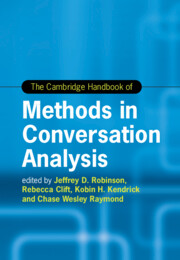Book contents
- Frontmatter
- Contents
- List of Tables
- List of Contributors
- Part I Introduction
- Part II Points of Departure
- Part III Collections
- Part IV Evidence
- Part V Avenues into Action
- 18 Single-Case Analysis
- 19 Ethnomethodology, Conversation Analysis, and the Study of Interaction in Everyday Life
- 20 Analyzing Categorial Phenomena in Talk-in-Interaction
- 21 Where the Action Is: Positioning Matters in Interaction
- 22 Analyzing Particles
- 23 Analyzing Grammar in Social Interaction
- 24 Listening to Talk-in-Interaction: Ways of Observing Speech
- 25 Multimodality in Conversation Analysis
- 26 System-Oriented Analysis: Moving from Singular Practices to Organizations of Practice
- 27 Comparing across Languages and Cultures
- 28 Methodological Considerations When Using Conversation Analysis to Investigate Institutional Interaction
- 29 Methods for ‘Applying’ Conversation Analysis
- 30 Using Conversation-Analytic Research Methods in the Study of Atypical Populations
- Part VI Situating and Reporting Findings
- Part VII Looking Forward
- Appendix I Jeffersonian Transcription Conventions
- Appendix II Multimodal Transcription Conventions
- Index
27 - Comparing across Languages and Cultures
from Part V - Avenues into Action
Published online by Cambridge University Press: 06 December 2024
- Frontmatter
- Contents
- List of Tables
- List of Contributors
- Part I Introduction
- Part II Points of Departure
- Part III Collections
- Part IV Evidence
- Part V Avenues into Action
- 18 Single-Case Analysis
- 19 Ethnomethodology, Conversation Analysis, and the Study of Interaction in Everyday Life
- 20 Analyzing Categorial Phenomena in Talk-in-Interaction
- 21 Where the Action Is: Positioning Matters in Interaction
- 22 Analyzing Particles
- 23 Analyzing Grammar in Social Interaction
- 24 Listening to Talk-in-Interaction: Ways of Observing Speech
- 25 Multimodality in Conversation Analysis
- 26 System-Oriented Analysis: Moving from Singular Practices to Organizations of Practice
- 27 Comparing across Languages and Cultures
- 28 Methodological Considerations When Using Conversation Analysis to Investigate Institutional Interaction
- 29 Methods for ‘Applying’ Conversation Analysis
- 30 Using Conversation-Analytic Research Methods in the Study of Atypical Populations
- Part VI Situating and Reporting Findings
- Part VII Looking Forward
- Appendix I Jeffersonian Transcription Conventions
- Appendix II Multimodal Transcription Conventions
- Index
Summary
In the early years of its development, CA research focused on data from English to explicate various organizations of interaction. As the number of researchers working with languages other than English has steadily increased, a question has arisen as to how organizations of interaction and practices used in them compare and contrast across different languages and cultures. As a result, there is now a burgeoning body of CA research undertaking crosslinguistic/cross-cultural comparison of interactional practices. On the one hand, comparative CA research can attest to the robustness and possible universality of the generic organizations of interaction that have been described in CA research based on examination of a small number of languages/cultures. On the other hand, comparative research can demonstrate the diversity of methods and practices by which humans deal with common (and perhaps universal) interactional problems. In this chapter, we discuss research methods and analytic techniques used in comparative CA research to give the reader some tips about how to begin and carry out this type of research. We also consider some analytic difficulties/challenges associated with comparative research so that the reader becomes aware of conceptual caveats when conducting crosslinguistic/cross-cultural comparison of interactional practices.
- Type
- Chapter
- Information
- The Cambridge Handbook of Methods in Conversation Analysis , pp. 780 - 808Publisher: Cambridge University PressPrint publication year: 2024

